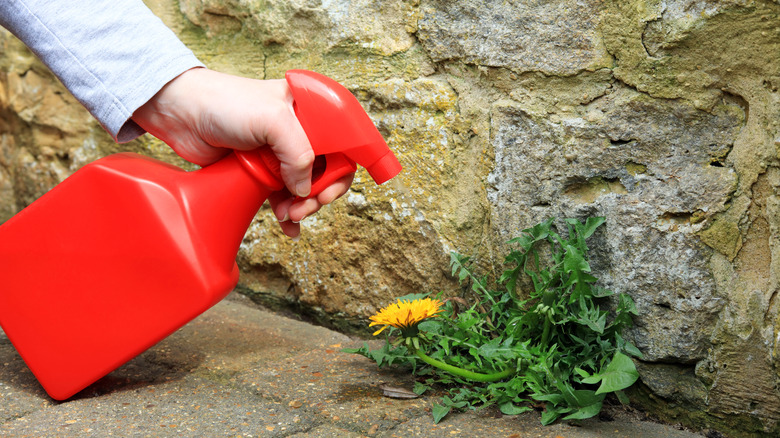You Only Need 3 Ingredients For Martha Stewart's DIY Weed Killer
Tending to a garden is a rewarding endeavor and can even have health benefits like reducing stress and improving mood. However, gardening is not all sunshine and roses. In fact, it often requires a lot of hard work and maintenance, especially when it comes to managing weeds. Luckily, Martha Stewart has you covered on weed management with her easy recipe for a DIY weed killer which only has three ingredients — white vinegar, lemon juice, and dish soap.
This weed killer is a great option for gardeners who want to move away from chemical herbicides and go with a more environmentally friendly solution that actually works. The main ingredient of this DIY weed killer, vinegar, has been proven to be an environmentally safe and potent weed killer and is a great inexpensive herbicide option for organic farmers, per the USDA. Furthermore, Adding lemon juice to the mix helps damage the weed's foliage by drying out and killing its leaves. Dish soap, on the other hand, works on a cellular level and breaks down plant structures to cause dehydration. It also helps the other ingredients stick to the plant and cause more damage. All three ingredients together create the perfect natural solution for common garden weeds.
How to make and use Martha Stewart's weed killer
According to her video on YouTube, all you need to make Martha Stewart's natural weed killer is one quart of white vinegar, one-fourth cup of lemon juice, and one tablespoon of biodegradable dish soap. Then, simply stir all the ingredients together, transfer the mixture into a bottle, and spray on any weeds in your yard or garden you'd like to get rid of.
However, before you get started, it is important to note that this mixture is a danger to all plants so you should be careful where you spray it and make sure to avoid any garden plants you don't want to kill. You should also choose to spray your weeds on warm calm days because vinegar-based weed killer is also most effective when the temperature is above 70 degrees Fahrenheit and there is no wind or rain. Furthermore, household vinegar is often quite diluted and is most likely to work best on younger weeds in the early spring. If you are treating older, more stubborn weeds, you may need to apply the solution to the plant multiple times over weeks for it to be effective.
Making your weed killer stronger
If your normal white distilled household vinegar isn't doing the trick on certain weeds, the easiest way to make your DIY weed-killing mixture stronger is to purchase stronger vinegar. Cooking vinegar typically only contains around 5% vinegar and 95% water. To up the oomph of your herbicide consider purchasing 20% horticultural vinegar from a garden center or 30% cleaning vinegar from a home improvement store. Research from the USDA found that 20% vinegar was enough to damage and kill the majority of weeds.
The main downside of using a natural vinegar-based weed killer is that while it does a good job of damaging the above-ground parts of a plant, it doesn't do much to damage the roots. This means that certain weeds may grow back after vinegar treatments. If you want a solution that tackles the roots of a plant, you can try adding salt to the mixture. However, table salt is quite toxic to plant life and you will need to be careful when using it because, if enough of it builds up in the soil, it can cause the ground you treated to become barren and plantless for years.


